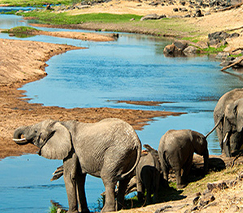
Augustino
Expeditions
Tanzania Southern
Saadani is where the beach meets the bush. Having an area of 1,100 sq km (430 sq miles) Saadani is the only wildlife sanctuary in East Africa to boast an Indian Ocean beachfront; it possesses all the attributes that make Tanzania's tropical coastline and islands so popular with European sun-worshippers. Located on the north coast, roughly 100km (60 miles) northwest of Dar es Salaam, yet Saadani is also one of the place where those idle hours of sunbathing might be interrupted by an elephant strolling past, or a lion coming to drink at the nearby waterhole! Palm trees sway in a cooling oceanic breeze. White sand and blue water sparkle alluringly beneath the tropical sun. Traditional dhows sail slowly past, propelled by billowing white sails, while Swahili fishermen cast their nets below a brilliant red sunrise. Protected as a game reserve since the 1960s, in 2002 it was expanded to cover twice its former area. The reserve suffered greatly from poaching prior to the late 1990s, but recent years have seen a marked turnaround, due to a concerted clampdown on poachers, based on integrating adjacent villages into the conservation drive. Today, a surprisingly wide range of grazers and primates is seen on game drives and walks, among them giraffe, buffalo, warthog, common waterbuck, reedbuck, hartebeest, wildebeest, red duiker, greater kudu, eland, sable antelope, yellow baboon and vervet monkey. Herds of up to 30 elephants are encountered with increasing frequency, and several lion prides are resident, together with leopard, spotted hyena and black-backed jackal. Boat trips on the mangrove-lined Wami River come with a high chance of sighting hippos, crocodiles and a selection of marine and riverine birds, including the mangrove kingfisher and lesser flamingo, while the beaches form one of the last major green turtle breeding sites on mainland Tanzania.
The wild animals most frequently encountered are Maasai giraffe, zebra, impala, warthog, wildebeest, Lichtenstein's hartebeest, sable antelope, buffaloes, baboons, waterbuck, hippos, elephant, wild dogs, crocodile and lion. Mikumi National Park is located in Morogoro region along the Dar es Salaam–Iringa main road.
The park covers an area of 3,230 square kilometers. The park can easily visited from Dar es Salaam or Iringa with 294 kilometers and 217 kilometers away respectively. The Mikumi topography covers the flood plains of the Mkata River, grassland and woodland. Also it's bordered by the Lumango and Uluguru mountains.
In Mikumi there are abundant birdlife along its wetland and surround, others are not found in northern circuit of the country. These include violet-crested Turaco, brown-necked parrot, white-backed night heron, green pigeon, and white-headed black chat among others.
The game reserve derive its name from the hunter-explorer Frederick Courtney Selous, whose books about his exploits were best sellers in Victorian England. Selous was killed by an Elephant in early 1900's during the First World War. The Selous Game Reserve is the largest protected wildlife area in Africa.
Only in the Serengeti will visitors see a greater concentration of wildlife. Yet Selous boasts Tanzania's largest population of elephant as well as large numbers of buffalo, hippo and wild dog. The remaining African Black Rhinos are also dominating the reserve. Other species commonly seen are sable antelope, bushbuck, impala, giraffe, lion, eland, baboon, zebra, crocodiles, leopard and greater kudu. The topography of Selous varies from rolling savannah woodland, grassland plains and rocky outcrops cut by the Rufiji River and its tributaries, the Kilombero and Luwegu, which together cover the greatest catchments area in East Africa.
The Rufiji, which flows from north to south, provides the life-blood of the Selous and sailing or rafting down the river is a wonderful method of seeing game, especially during the dry season between June and October. The Rufiji River outside the reserve has a delta which accommodates numerous birdlife species appropriate for the bird watchers to visit.
The Ruaha National Park lies between two large rivers of Great Ruaha River and Njombe with its vast area covers 12,950 sq km and still comparatively unexplored bird and game sanctuary. It's the second largest National park after Serengeti with the largest Elephants sanctuary in the country.
The topography of Ruaha is lush plains, open grasslands, thickets, flood plains and woodland. Also the park is bordered by mountains with altitude of 1,600 meters to its massif Ngalambulwa. The common wild animals that inhabit the Ruaha National Park are herds of Giraffe, Buffalo, Greater Kudu and Impala during the dry season of June through November.
Others include roan and sable antelope, lesser kudu, hartebeest, hippos, common zebras, and warthog among other herbivores. The carnivores such as hunting dogs, lion, spotted hyena, fox, leopard, cheetah and crocodile resting to the river banks.
Along the Ruaha river and the surrounding generally noted the richness of the birdlife others not found elsewhere in East Africa. These include rare raptorial eleonora's falcon, migrating flocks. Others are marabou stork, dickinson 's kestrel, bat hawk, European hobby, red necked falcon among the list.






